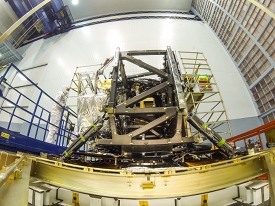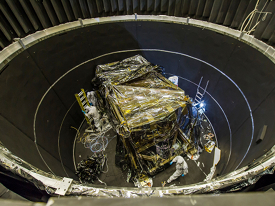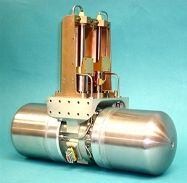#04: MIRI keeps cool under low pressure
3 February 2014
The Mid-Infrared Instrument (MIRI) on JWST has performed beautifully during its first cryo-vacuum test campaign carried out at NASA's Goddard Space Flight Center towards the end of last year. An examination of data recorded during those tests confirms that the instrument is in good health and performing well.In August last year preparations began for the first ISIM (Integrated Science Instrument Module) test campaign to be performed in a vacuum and at cryogenic temperatures. Fitted with two instruments - MIRI and FGS/NIRISS (the Fine Guidance Sensor / Near-InfraRed Imager and Slitless Spectrograph) - ISIM was installed in the Space Environment Simulator (SES), a large cryogenic test chamber at Goddard. The doors to the chamber were closed on 29 August and after about 5 days the vacuum (approximately 10-6 mbar) was achieved, ISIM and the instruments were checked to be functioning and in good shape, and the cool-down then began.
 |
 |
| Left: ISIM with MIRI and FGS/NIRISS, mounted on a test rig; right: ISIM inside the SES chamber at Goddard. Credit: NASA / Chris Gunn | |
 |
|
The cryocooler under development for MIRI. Credit: Northrop Grumman |
Nearly twenty days later, the ISIM reached a temperature of
During the almost three-week cool down of MIRI, team members on-site at Goddard, across Europe and elsewhere in the US monitored the health of the instrument, 24 hours a day, seven days a week.
Once the Optical Telescope Simulator (OSIM), ISIM, MIRI and FGS/NIRISS all reached their operating temperatures, the scientists and engineers resumed their tests, constantly monitoring the state of the instruments, as well as conducting their experiments and analysing the data.
.jpg) |
| Left: Thermal and vacuum test rig for ISIM. Credit: NASA / Chris Gunn. |
Every indication showed that MIRI performed well, however, not even scientific experiments deep in the Goddard cryogenic test chamber are immune from external perturbations and on 1 October all testing was put on hold as the American government shut down.
Once the furlough ended, testing started again on 17 October. To reduce the impact of the unscheduled ‘break’, the sequence of tests was revised and heavily streamlined. The most critical activities were given the highest priorities and tested accordingly.
Despite this interruption, and due to the great efforts from all of the teams, the tests at operating temperature were successfully completed on 29 October and all of the primary goals of the first ISIM test campaign were reached. Warm-up then started and was finished in the week of 11 November, after which this first ISIM cryo-vacuum test campaign was officially declared complete.
This was the first time MIRI could be tested at its operating temperature since the instrument-level testing at RAL in Europe in 2011. The data gathered by the MIRI team have shown that the instrument performed beautifully and is in good health.
About JWST
The James Webb Space Telescope (JWST) will be a general-purpose observatory with a 6.5-m telescope optimised for infrared observations and a suite of four astronomical instruments capable of addressing many of the outstanding issues in astronomy. The primary aim is to examine the first light in the Universe - those objects which formed shortly after the Big Bang. Further aims include: looking at how galaxies form; the birth of stars; and the search for protoplanetary systems and the origin of life, including the study of exoplanets. JWST is a joint project of NASA, ESA and the Canadian Space Agency. It is scheduled for launch in 2018 by an Ariane 5 and will operate approximately 1.5 million kilometres from the Earth in an orbit around the second Lagrange point of the Sun-Earth system, L2.
About MIRI
The Mid-Infrared Instrument (MIRI) is one of four instruments on JWST. MIRI will provide direct imaging, medium- and low-resolution spectroscopy, and coronagraphic imaging. It is expected to make important contributions in all of the primary science aims of JWST. MIRI was developed as a partnership between Europe and the USA - the main partners are a consortium of nationally funded European institutes (the MIRI European Consortium), the Jet Propulsion Laboratory (JPL), ESA, and NASA's Goddard Space Flight Center (GSFC).




